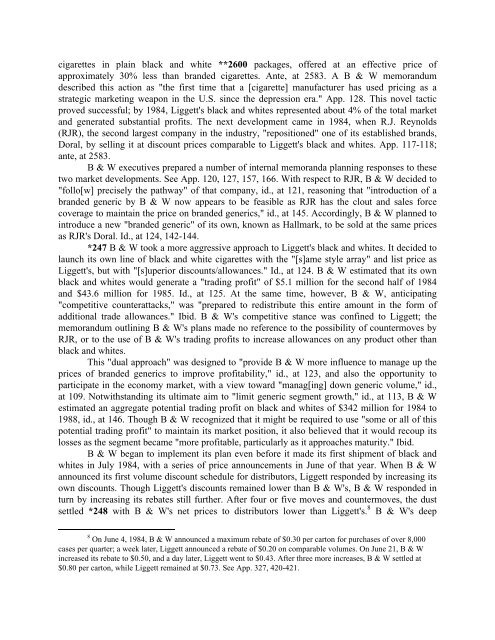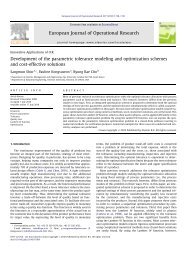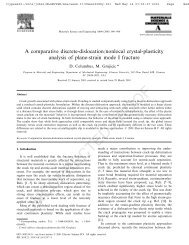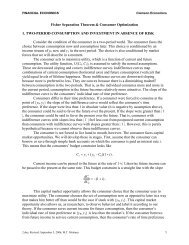509 U.S. 209, 113 S.Ct. 2578 BROOKE GROUP LTD., Petitioner v ...
509 U.S. 209, 113 S.Ct. 2578 BROOKE GROUP LTD., Petitioner v ...
509 U.S. 209, 113 S.Ct. 2578 BROOKE GROUP LTD., Petitioner v ...
Create successful ePaper yourself
Turn your PDF publications into a flip-book with our unique Google optimized e-Paper software.
cigarettes in plain black and white **2600 packages, offered at an effective price of<br />
approximately 30% less than branded cigarettes. Ante, at 2583. A B & W memorandum<br />
described this action as "the first time that a [cigarette] manufacturer has used pricing as a<br />
strategic marketing weapon in the U.S. since the depression era." App. 128. This novel tactic<br />
proved successful; by 1984, Liggett's black and whites represented about 4% of the total market<br />
and generated substantial profits. The next development came in 1984, when R.J. Reynolds<br />
(RJR), the second largest company in the industry, "repositioned" one of its established brands,<br />
Doral, by selling it at discount prices comparable to Liggett's black and whites. App. 117-118;<br />
ante, at 2583.<br />
B & W executives prepared a number of internal memoranda planning responses to these<br />
two market developments. See App. 120, 127, 157, 166. With respect to RJR, B & W decided to<br />
"follo[w] precisely the pathway" of that company, id., at 121, reasoning that "introduction of a<br />
branded generic by B & W now appears to be feasible as RJR has the clout and sales force<br />
coverage to maintain the price on branded generics," id., at 145. Accordingly, B & W planned to<br />
introduce a new "branded generic" of its own, known as Hallmark, to be sold at the same prices<br />
as RJR's Doral. Id., at 124, 142-144.<br />
*247 B & W took a more aggressive approach to Liggett's black and whites. It decided to<br />
launch its own line of black and white cigarettes with the "[s]ame style array" and list price as<br />
Liggett's, but with "[s]uperior discounts/allowances." Id., at 124. B & W estimated that its own<br />
black and whites would generate a "trading profit" of $5.1 million for the second half of 1984<br />
and $43.6 million for 1985. Id., at 125. At the same time, however, B & W, anticipating<br />
"competitive counterattacks," was "prepared to redistribute this entire amount in the form of<br />
additional trade allowances." Ibid. B & W's competitive stance was confined to Liggett; the<br />
memorandum outlining B & W's plans made no reference to the possibility of countermoves by<br />
RJR, or to the use of B & W's trading profits to increase allowances on any product other than<br />
black and whites.<br />
This "dual approach" was designed to "provide B & W more influence to manage up the<br />
prices of branded generics to improve profitability," id., at 123, and also the opportunity to<br />
participate in the economy market, with a view toward "manag[ing] down generic volume," id.,<br />
at 109. Notwithstanding its ultimate aim to "limit generic segment growth," id., at <strong>113</strong>, B & W<br />
estimated an aggregate potential trading profit on black and whites of $342 million for 1984 to<br />
1988, id., at 146. Though B & W recognized that it might be required to use "some or all of this<br />
potential trading profit" to maintain its market position, it also believed that it would recoup its<br />
losses as the segment became "more profitable, particularly as it approaches maturity." Ibid.<br />
B & W began to implement its plan even before it made its first shipment of black and<br />
whites in July 1984, with a series of price announcements in June of that year. When B & W<br />
announced its first volume discount schedule for distributors, Liggett responded by increasing its<br />
own discounts. Though Liggett's discounts remained lower than B & W's, B & W responded in<br />
turn by increasing its rebates still further. After four or five moves and countermoves, the dust<br />
settled *248 with B & W's net prices to distributors lower than Liggett's. 8 B & W's deep<br />
8 On June 4, 1984, B & W announced a maximum rebate of $0.30 per carton for purchases of over 8,000<br />
cases per quarter; a week later, Liggett announced a rebate of $0.20 on comparable volumes. On June 21, B & W<br />
increased its rebate to $0.50, and a day later, Liggett went to $0.43. After three more increases, B & W settled at<br />
$0.80 per carton, while Liggett remained at $0.73. See App. 327, 420-421.
















